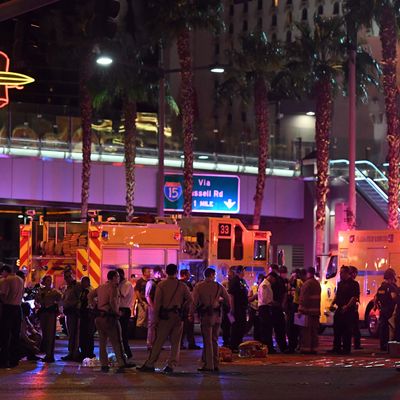
In the immediate wake of Sunday night’s massacre in Las Vegas, journalists and horrified viewers quickly began asking a set of questions that have become sadly familiar: Why did Stephen Craig Paddock do what he did? How did he get his weapons? What policy changes could have prevented this catastrophe?
But another, more meta question also bubbled up shortly after news of the shooting began to spread: Is the media contributing to these attacks through how it covers them? This, too, has become a fairly standard question to ask in the age of mass shootings, and a number of smart people have decided the answer is yes. Their argument is summed up concisely by the Texas State University researchers behind the website Don’t Name Them — them being shooters — who argue that “Some shooters are motivated by a desire for fame, notoriety, and/or recognition,” it is a mistake for journalists to grant them exactly that, in part because doing so can inspire copycast.
Zeynep Tufekci, a University of North Carolina psychologist and New York Times columnist who writes about the intersection of technology, culture, and politics, has also been covering the copycat issue for a while. Here are some highlights from a tweetstorm she posted Monday on the issue, drawing on some of her past work on this issue:
At first glance, these seem like fairly reasonable requests, like a way for the institution of journalism to play the role of a responsible curator of information rather than a crass sensationalizer of violence. But if you actually dig down into these suggestions, it’s unclear exactly what it would look like for outlets to follow them, or how they could do so while still retaining their responsibilities to provide accurate breaking news.
Let’s grant that there are fairly gross, exploitative ways to cover tragedies — blurring the line between real-life violence and action movies — and all outlets should avoid them. But Tufekci and other media critics are making a more substantive critique than that. And it isn’t a particularly realistic one. In a 2015 column about the murder of a Virginia TV reporter and her cameraman captured on live TV and in a surreal first-person video on the killer’s Facebook feed, for example, Tufekci explained:
[Covering these events more responsibly] doesn’t mean censoring the news or not reporting important events of obvious news value. It means not providing the killers with the infamy they seek. It means somber, instead of lurid and graphic, coverage, and a focus on victims. It means not putting the killer’s face on loop. It means minimizing or not using the killers’ names, as I have done here. It means not airing snuff films, or making them easily accessible on popular sites. It means holding back reporting of details such as the type of gun, ammunition, angle of attack and the protective gear the killer might have worn. Such detailed reporting can give the next killer a concrete road map.
When a violent act occurs, everyone wants to know who did it and what it was like to be there. This is human nature. People will seek out any information they can about the perpetrators and the nature of the attack. That’s why information about a given killer and photos and video of a given attack always dominate the news so much: this is what people want to know. What quantity of photo-showing or name-naming would reduce the risk of copycats? How much video replaying is too much?
These questions are particularly pointed in the age of fake news, a subject Tufekci has written about at length. If media outlets don’t provide useful, attention-grabbing information about an attack, it will only become easier for hoaxsters, trolls, and gonzo ideological (mostly far-right) outlets to carve out an even bigger place in the conversation. We should want outlets to provide the real name of the attacker, and real information — including, yes, hard-to-watch video — about what went down. This can serve as a partial bulwark against the spread of false and needlessly inflammatory nonsense.
As Tufekci and others have noted, there is fairly solid evidence that media coverage can lead to copycat attacks. But there could also be benefits to airing detailed information about these attacks: Detailed reporting on the Columbine High School massacre, for example, garnered plenty of information about how Dylan Klebold and Eric Harris carried out their attacks, from their “training” in its run-up to where they got their arsenal, that could help future family members or school administrators notice warning signs they might otherwise miss. So it could both be the case that certain types of detailed reporting could occasionally inspire copycats and that in the long run, society is better off for having this information be available.
Finally, it’s worth pointing out that mass shooters always have been and always will be famous. That is what happens when you do a horrible thing that garners a great deal of attention, and there’s really no way around it. It’s unfortunate that there is a small subset of deeply disturbed people who could be swayed by this fact, but it’s simply silly to pretend that it will ever be the case that mass shooters will not garner significant attention for their crimes — especially in the social-media age, when the question of which information gets passed around is determined by hundreds of millions of people instead of a small group of elite media outlets.
In short, saying “We should try to prevent mass shooters from becoming famous” is a bit like saying “We should try to stop 14-year-olds from being fascinated by sex.” It’s a nice sentiment, and if there were any way to accomplish it it would probably improve society a bit — but given that humans are humans, it just isn’t a realistic goal.





























